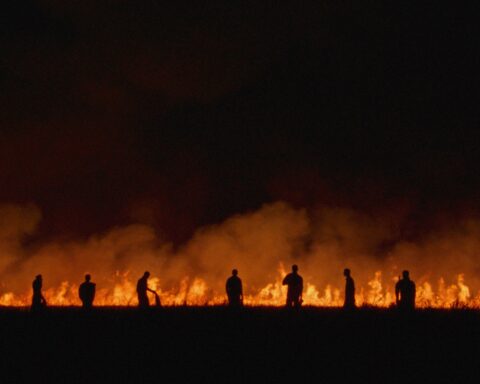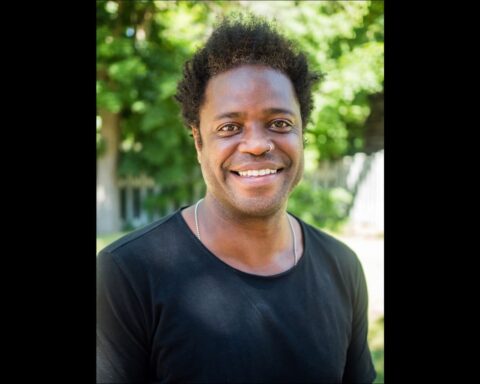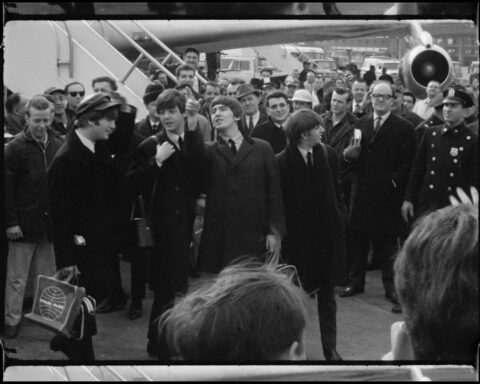When I first arrived in Toronto from my home in Amman, Jordan, I was struck by how few people here had any understanding of what life was really like in the Middle East. I was in the MFA in Documentary Media program at Ryerson University, where I created a short documentary about my grandparents and their unusual love story, Teta, Opi & Me. At one point, my rough cut was screened for feedback and there was one remark by a professor, of Canadian origin, that at first angered me, then saddened me and finally drove me to ask, “Why?” His only remark after watching my film was that he was genuinely surprised that we, the Middle Eastern people, live “normal” lives. He was taken aback that the film did not show war, but instead featured beautiful scenery, three-dimensional people and everyday “normal” living. So, why was violence the only reality he knew of the Middle East? Is his attitude similar to most, if not all North American audiences? What are the stories being told about the Middle East, how are they being told, and does it matter who is documenting them?
Teta, Opi & Me Official Trailer from Tara Hakim on Vimeo.
One cannot negate the fact of the chaotic nature of existence in much of the region, and the importance of documenting those stories and realities. Nor can one dispute the impact those documentaries have had in illuminating the region and in creating discussion, action and change. And yet, it is vital to consider how these stories are being told, who is doing the telling and what other perspectives are out there, if any.
A Syrian Love Story, directed by Sean McAllister, offers a glimpse into current Middle Eastern conflicts that look past the headlines and attempt to reveal the human beings involved. The film begins in 2009, with McAllister in Syria looking for a “real” story about political prisoners. One local woman tells him “Why are you looking for something negative?” to which McAllister replies “Political prisoners are real.” McAllister is right, political prisoners are real, but what the local woman hints at is precisely the lack of any representation outside of conflict and the limited perspective that many people have about the Middle East from their cocoons in North America. Fortunately, McAllister changes route when he meets Amer, a Palestinian freedom fighter, and his wife Raghda, a political prisoner.
Shot over five years, A Syrian Love Story is McAllister’s take on their journey. Imprisonment, both literal and figurative, is a central thread in the film. At first, Raghda’s absence as she serves a nine-month sentence creates a gaping hole in the family as Amer and the boys suffer by her absence. Later, in Lebanon, exile becomes another form of confinement, which Raghda tries to escape by leaving her family and returning to Syria, leaving Amer, yet again, feeling trapped. Eventually, Raghda returns and, based on her status as a former political prisoner, the family is granted asylum in France. As their children assimilate to life in France, Raghda and Amer’s marriage slowly disintegrates and, through it all, McAllister is there, documenting the story.
The time spent shows: there is a clear trust between McAllister, a white British male, and the Syrian family. McAllister, an outsider, succeeds in moving away from the conventional Syria film and offers a more intimate story about individuals and their everyday lives. And yet, the film misses the opportunity to delicately explore the intersection of national trauma with the tensions of domestic life.
By asserting his presence, McAllister makes no claims of objectivity and allows for a more honest story to unfold, but at the same time he is too present, sometimes unbearably so. We hear every question he asks, always in English—his native language, not theirs. This illuminates his Western white male gaze telling a story about the “other.” Moreover, by confining dialogue between McAllister and his subjects to English, the film not only undermines their abilities to express themselves, but also the breadth of McAllister’s questions: “Are things good now in France?” This is most frustrating when Raghda and Amer attempt and fail to rebuild their relationship on camera by communicating their respective positions. It is impossible to know whether the pauses and hesitations are due to emotion and trauma or a lack of English vocabulary. By denying its protagonists the means to fully articulate themselves, the film inadvertently reiterates the political repression they suffered deeply from back home and further confines in their European exile.Then there is the film’s exclusion of the Syrian milieu from its vision of life in exile, which especially damages its treatment of Raghda, who suffers precisely from her desire to be equally faithful to her politics and her family. As all context of the revolution leaves the film with their move to France, so does the meaning of her struggle. In one scene in particular, after Raghda has just attempted suicide, McAllister asks her why she feels that “everything is bad.” She avoids eye contact and appears like a careless, unfit mother. By omitting all that is happening in Syria, the film winds up taking Amer’s side, and Raghda ceases to be who she had been. In a prerecorded post-screening talk, McAllister clarified this framing, saying that the film “completely lost a lot of the context … [and] worked for what we wanted to do, which is make a bigger audience as possible in a TV market and tell a human story.” This is McAllister wanting to take a swim and not get wet.
Similarly, Of Fathers and Sons, directed by Talal Derki, takes a departure from making a film about the Syrian war and its violence. Instead, Derki makes a film about the movement of violence from generation to generation and examines life behind closed doors. He returns to his native land, Syria, and for over two years lives with Abu Osama, a member of Al-Nusra Front (also known as Al-Qaeda), and his family. To do so, Derki had to go deep undercover. “I found that there was no dialogue between me and them,” Derki told the radical new media organization Brave New Films. “The only way to really film from the inside…and do all that observing, you have to be exactly like them…so I decided to be a Salafist guy with a camera.” And it worked.
With unprecedented access into powerfully revealing and disturbing content, Of Fathers and Sons transports us into the pervasive culture of violence inside a jihadi family and offers an intimate glimpse into the gradual radicalization of young males. Derki keeps himself out of the story as much as possible and avoids too much moralizing or even authoring, allowing his camera and presence to fade into the background of most scenes. Through taking this observational stance, Derki avoids the normalization of Abu Osama and his kind.
This world of violence feels genuine, and worst of all, normal to those living there. Abu Osama is not the typical jihadi face one would expect: he looks like a normal loving father. At the same time, he spends his life fighting for the cause and the dream of creating the caliphate. He disarms landmines, shoots people from a sniper position and plans attacks. His sons, as we get to see, are being raised in this circle of violence and are being prepared to follow in their father’s footsteps. By the second half of the film, Abu Osama’s eldest son is participating in an Al-Qaeda training camp. In a shocking and harrowing scene, the boys are told to lie still on the ground while bullets are shot next to and around their bodies in order to make them lose their fear.
This remarkable access into a world one imagines but can never see is only possible because Derki took the leap and risked his life. Posing as a pro-jihadi war photographer was necessary, but being a Middle Eastern man was vital. Derki laboured to gain access and trust, spending almost 330 days filming the family and limiting his crew to only one other member to protect the intimacy and closeness. McAllister did the same, spending five years with the family, but in his case, his Western voice was a bit imposing and domineering, and the Middle Eastern subjects were confined to express themselves in a language that is not theirs. That said, both McAllister and Derki succeeded in diverging from the conventional war-torn movies and instead divulged a more intimate, personal story that is situated within the context of conflict. No matter how close the directors became to their subjects (even if Derki’s closeness is untruthful but necessary to make the film and stay alive), both directors succeed in showing us that the story, of Raghda and Amer or Abu Osama and his sons, is a microcosm of a more global crisis.
No filmmaker can negate the tumultuous nature of the region and the importance of documenting those areas. Viewing the work of Derki and McAllister, it’s clear that the origin of the director only matters so much. The portrayal of the subjects and their stories are more dependent on the approach the director takes: the time put in, the access and trust gained, the treatment of the characters and most importantly, the position and stance the directors put themselves in. Both films attempt to look past headlines and reveal the human beings involved, although one does it better than the other. Both films divert from showing us more war-torn images, dead bodies and newsworthy stories. And yet, these are just two film—albeit good ones—out of hundreds about the Middle East and the conflict. There was life before conflict, there is life during conflict and there will be life after conflict. The audience misses the bigger picture: there is more to the Middle East than just warfare.
In Teta, Alf Marra (Grandma, A Thousand Times), Lebanese director Mahmoud Kaabour shows us just that. The poetic, playful, and reflexive documentary centers around the filmmaker’s feisty Lebanese grandmother, Fatima, as she grows older and her once bustling house is now silent. Formally interesting—a doc hybrid—it is also about Kaabour’s relationship with his grandmother. Inspired by violin recordings his late grandfather left behind, the filmmaker returns to Lebanon, back to the house of Teta, where we are invited inside and treated to acts of love that only a grandmother, any grandmother, knows how to impart. Together, grandmother and grandson evoke distant memories, particularly those of her much-missed violinist husband and Beirut in the old days, with the window behind them transformed into a magic screen where dreamlike imagery unfolds. This formal intervention is one of many that elevate this film to a documentary-fiction hybrid, but also one that invests all manner of distancing devices permeated with emotional resonance. These playful fictional scenes or setups intensify the conspiratorial ties between Kaabour and Teta. They reconnect, converse, reminisce, perform, laugh, and cry on screen, and we are witnesses to all these acts of kinship—what is private is made public.
Teta, Alf Marra (Grandma, A Thousand Times) by Mahmoud Kaabour – Trailer from Screen Institute Beirut on Vimeo.
Kaabour’s intimate and inventive tribute to his grandmother delicately deconstructs the family-portrait genre and offers a rare glimpse into the day-to-day lives of a Lebanese family—a world North American viewers rarely see, and yet one that is not that different from lives in the West. Kaabour, like any grandson, holds on to his grandmother and doesn’t want her to die. Fatima, like any grandmother, cares, worries about and holds the family together. And like any elderly person, Fatima grapples with her imminent demise and prepares for the occasion. Teta, Alf Marra emerges as a poetic consideration of the importance of family, a sense of place, the pertinence of memory and the inescapability of aging and mortality. It taps into the universal desire to hang onto loved ones in their fading years, and if anything, it will inspire a phone call to your grandparents.
Similarly, in Kedi, Turkish filmmaker Ceyda Torun turns her camera on the ordinary, the everyday and the mundane. As the director describes it, it is a love letter written to Istanbul and its cats. Torun, in her beautiful cat-level footage, captures so beautifully and powerfully kindness in its purest form, simply by observing cats and listening to their caretakers across the city. Watching Kedi transported me back home and showed me life in the Middle East as I know it, which has not been affected by conflict. It’s important for Western eyes to see that there are films like Teta, Alf Marra and Kedi that attempt to bridge that gap in representation and show life in the Middle East as it is beyond the conflict. Films about conflict in the Middle East are important and illuminate much of what is occurring in the region, but they only paint half the picture. Conflict should not be documented exclusively, repeatedly, and without context.
A friend, who is European and saw Kedi alongside me, feels that watching it changed his perception of films that revolve around conflict. By seeing a slice of life outside of conflict, and viewing people enjoying “normal” lives, the stories of those in conflict became more relatable. The people are no longer those who are suffering, but those who are simply living in, and dealing with, an area affected by conflict—no longer a plea for sympathy but an uncovering of commonality.

Kamil in _Kedi_
Oscilloscope Films
_Of Fathers and Sons_
Kino Lorber
_Of Fathers and Sons_
Kino Lorber
_Teta, Alf Marra_ (_Grandma, A Thousand Times_)
Veritas Films
_A Syrian Love Story_
_Kedi_
Oscilloscope Films
_Kedi_
Oscilloscope Films
_Kedi_
Oscilloscope Films












